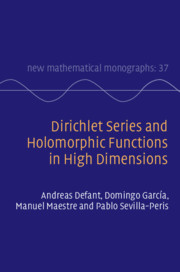Book contents
- Frontmatter
- Contents
- Introduction
- Part 1 Bohr’s Problem and Complex Analysis on Polydiscs
- 1 The Absolute Convergence Problem
- 2 Holomorphic Functions on Polydiscs
- 3 Bohr’s Vision
- 4 Solution to the Problem
- 5 The Fourier Analysis Point of View
- 6 Inequalities I
- 7 Probabilistic Tools I
- 8 Multidimensional Bohr Radii
- 9 Strips under the Microscope
- 10 Monomial Convergence of Holomorphic Functions
- 11 Hardy Spaces of Dirichlet Series
- 12 Bohr’s Problem in Hardy Spaces
- 13 Hardy Spaces and Holomorphy
- Part 2 Advanced Toolbox
- Part 3 Replacing Polydiscs by Other Balls
- Part 4 Vector-Valued Aspects
- References
- Symbol Index
- Subject Index
13 - Hardy Spaces and Holomorphy
from Part 1 - Bohr’s Problem and Complex Analysis on Polydiscs
Published online by Cambridge University Press: 19 July 2019
- Frontmatter
- Contents
- Introduction
- Part 1 Bohr’s Problem and Complex Analysis on Polydiscs
- 1 The Absolute Convergence Problem
- 2 Holomorphic Functions on Polydiscs
- 3 Bohr’s Vision
- 4 Solution to the Problem
- 5 The Fourier Analysis Point of View
- 6 Inequalities I
- 7 Probabilistic Tools I
- 8 Multidimensional Bohr Radii
- 9 Strips under the Microscope
- 10 Monomial Convergence of Holomorphic Functions
- 11 Hardy Spaces of Dirichlet Series
- 12 Bohr’s Problem in Hardy Spaces
- 13 Hardy Spaces and Holomorphy
- Part 2 Advanced Toolbox
- Part 3 Replacing Polydiscs by Other Balls
- Part 4 Vector-Valued Aspects
- References
- Symbol Index
- Subject Index
Summary
We study the relationship between Hardy spaces of functions on the polytorus and certain spaces of holomorphic functions. We deal first with functions in finitely many variables, and later we jump to the infinite dimensional setting. For each N we consider the space of holomorphic functions g on the N-dimensional polydisc for which the L_p norms of g(rz) for 0<r<1 are bounded (known as the Hardy space of holomorphic functions). For each p these two Hardy spaces (of integrable functions on the N-dimensional polytorus and the N-dimensional polydisc) are isometrically isomorphic. The main tool in the proof is the Poisson operator (defined in Chapter 5). For the infinite dimensional case, we define the space of holomorphic functions g on l_2 ∩ Bc0 whose restrictions to the first N variables all belong to the corresponding Hardy space, and the norms are uniformly bounded (in N). These Hardy spaces of holomorphic functions on l_2 ∩ Bc0 and the Hardy spaces of integrable functions on the infinite-dimensional polytorus are isometrically isomorphic. The jump is given using a Hilbert criterion for Hardy spaces.
Keywords
Information
- Type
- Chapter
- Information
- Dirichlet Series and Holomorphic Functions in High Dimensions , pp. 315 - 336Publisher: Cambridge University PressPrint publication year: 2019
